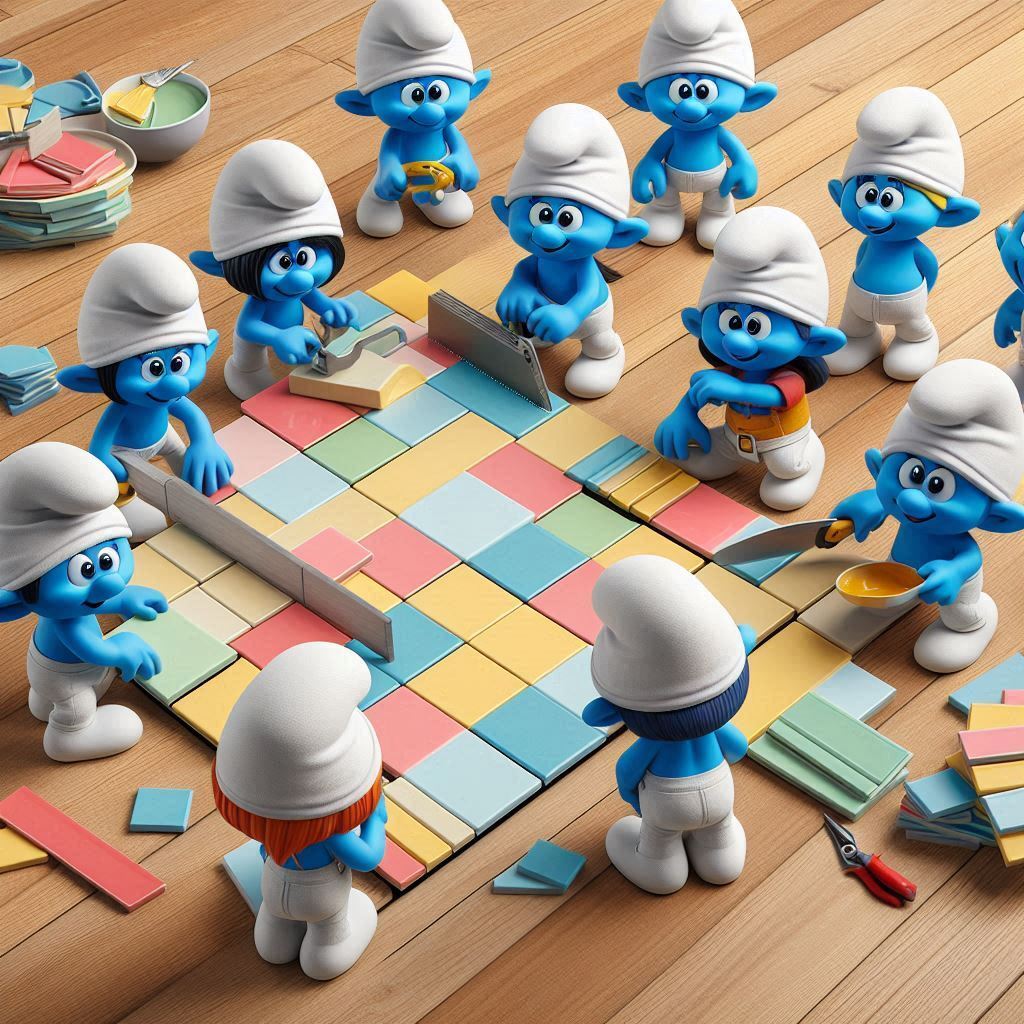Laying ceramic tiles is the ultimate embodiment of the ideas of the designer, architect, customer, besides it is not easy highly qualified work and art. Tiles are laid for many years and a lot depends on the quality of the process. Even the most expensive and beautiful tiles, laid haphazardly, will look terrible. While simple and inexpensive tiles laid by the hands of an experienced craftsman can look very beautiful. Therefore, a lot depends on the person who is engaged in this work. A tiler performs complex, painstaking and multidisciplinary work, which is why the cost of work by experienced craftsmen is not cheap.

In order to calculate the number of tiles for laying, you need to take into account the fact that:
- it almost always turns out that the length of the row is not a multiple of the length of the tile, and, therefore, it will have to be cut, protrusions and niches in the walls, faucets, bathroom sinks, and so on, also create the need to cut tiles;
- A certain number of tiles may be rejected, and several tiles may need to be left for possible repairs.
Therefore, after calculating the number of tiles by area for facing, you need to add another 10-15%.
Laying tiles always involves a certain sequence of work, let’s look at it on the example of laying tiles in an apartment.
We clean the base for laying from dirt, dust and fragile elements
In most cases, laying takes place in warm rooms after general construction work, so the surface for laying is thoroughly cleaned of dust, cement residues and other dirt.
We level the surface so that the level difference does not exceed 5 mm.
With a flat two-meter wooden or metal rail, we determine unevenness, and then use special putty mixtures to level the surface. You can also use a traditional cement-sand mortar.
Setting up the foundation
If tile adhesive is used in the work, then to prevent its absorption into the surface, after the leveling layer dries, a primer is applied to it.
Attach the rail
We install a metal or wooden rail horizontally on the wall, so that there is room under it for the basement (lower) row of tiles plus seams (this row is glued after laying floor tiles).
We prepare the required amount of glue
We start preparing the glue. Currently, there is a large selection of ready-made dry polymer-cement mixes and special adhesives for laying tiles. It is enough to follow the instructions on the package to prepare a high-quality tile adhesive, but, in addition, there are some general rules. The amount of glue should be such that you can fully use it by the time the mixture hardens. You also need to mix the mixture thoroughly, which is poured into water, and not vice versa. For 25 kg of the mixture, 5.5-6 liters of water are required. The entire solution is mixed manually or mechanically for about 5 minutes until a creamy mass is obtained.

If you want to save money, you can use a cement-sand mortar: mix cement (M400 or M500) – 1 part, sand-3 or 4 parts and dilute with water (approximately 0.5 parts). Also, instead of water, you can use a 3-5% aqueous solution of PVA glue, such a solution is mixed in smaller portions, since it sets faster.
We apply glue for laying on the wall
The prepared solution is applied to the wall and evenly distributed over it with a notched grater or spatula. In some cases, it is possible to apply the solution to the tile.
Directly laying tiles.
Bicotture and monocotture tiles can be moistened before installation
We start laying from the bottom. Between the tiles, leave a place for the seam. At the corners of the laid tiles, we put special plastic crosses so that the thickness of the seams is the same (most often it is 2-3 mm). After laying, we press the tile with our hand and remove the excess mortar until it hardens. In the process, we constantly check the levels of the laying level.
If you need to cut the tile, you can do this: use a glass cutter to make a cut on the tile from the side of the glaze, then hit the tile with the reverse side, for example, on the edge of the table. The tile splits along the incision. But it is better to use a special tool for cutting, especially for strong floor tiles.
So, we have finished laying the tiles, now you need to wait 24 hours before the glue sets.
Fill the joints with grout mixture
Prepare the grout mixture for the joints. Pour the mixture into a container with water, mix thoroughly and stand for 10 minutes, then mix again. Then fill the joints with grout using a rubber spatula.

I must say that the seams are important. The design project can include any options for the joint thickness: from 0 to 20 mm. Also, you can choose almost any color scheme for grouting joints. Make a reservation that properly rubbed seams enhance the aesthetic effect of laying, and in some cases can smooth out small defects in it. But in addition, the joint compensates for micro-coloration of the surface, which is especially important, for example, when laying tiles in new buildings or very large rooms.
Cleaning the tile surface
After 25-30 minutes, pre-clean the tile from excess mortar, it is best to use a sponge for this. After an hour, finally, with a flannel cloth, we clean the surface.
Distribution of tiles.
The general principle of tile distribution is clear to everyone-the most prominent places should look very good.
In other words, cut tiles can be used as much as possible in less visible places. If tiles of the same size are used on the floor and wall, it is recommended to align the joints on the wall and on the floor. If the wall is rectangular,a plumb line is placed in the middle, and the rows are aligned along it. On the floor, a guide cord is also stretched in the middle parallel to the walls and the first row is aligned with it.

Features of laying tiles in other rooms and on the street
Facing with ceramic tiles (especially granite) is also used in supermarkets and warehouses, on the street, in the pool, for facing fireplaces. Just make a reservation that first of all it is necessary to choose the right tile and special gluing and grout mixes that are suitable for the appropriate operating conditions.
Laying tiles in large areas and areas with high traffic intensity. The screed should be further reinforced by a larger thickness and by reinforcing with special materials. In large rooms, it is also necessary to use expansion joints for quenching microcollutions. The expansion joint should go deep into the screed by 10-20 mm. In order to avoid cavities between the tile and the screed as much as possible, it is recommended to apply a layer of glue both on the screed and on the tile. Then the tile is pressed and tapped with rubber hammers.
Laying tiles on the street. In this case, the screed must be made with the necessary slope so that all water goes beyond the veneered surface. It is also necessary to use expansion joints that go deep into the screed.
Tile maintenance
So, the tile is laid, of course, you want it to serve you for a long time. All you need to do is follow the operating conditions for your tile type. For example, to care for bicotture or monocotture tiles, a warm solution of water and a soft sponge are used. But polished ceramic granite is washed with an acidic solution during the first month of operation, because dirt is clogged into micropores. When cleaning glossy surfaces, do not use abrasive agents.
Follow all these simple rules, and the tile will delight your eyes for a long time.